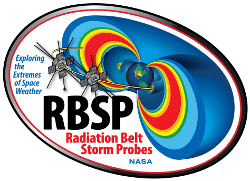 I recently had the amazing opportunity to go to the Kennedy Space Center as an invited guest to see the launch of a pair of spacecraft, the Radiation Belt Storm Probes (RBSP). This opportunity came to be through my position as a researcher at Fundamental Technologies, a small research firm in Lawrence, KS that will be the Science Operation Center (SOC) for the Ion Composition Experiment (RBSPICE). This was my first, and likely only, chance to see a launch as an invited guest, and my wife and I were over-the-moon excited, if you’ll forgive the pun.
I recently had the amazing opportunity to go to the Kennedy Space Center as an invited guest to see the launch of a pair of spacecraft, the Radiation Belt Storm Probes (RBSP). This opportunity came to be through my position as a researcher at Fundamental Technologies, a small research firm in Lawrence, KS that will be the Science Operation Center (SOC) for the Ion Composition Experiment (RBSPICE). This was my first, and likely only, chance to see a launch as an invited guest, and my wife and I were over-the-moon excited, if you’ll forgive the pun.
Unfortunately, the launch was delayed 24 hours from its originally scheduled launch time of Thursday, 08/23 at 0407 EDT because of a concern over the RD-180 engine on the Atlas V that RBSP was atop. There had been a problem with another RD-180 engine that was being fitted to another Atlas V in Alabama, and the engineers wanted to make sure that the same defect wasn’t present in RBSP’s engine. No worries from us, though, since we had reservations through Saturday. Plus, we didn’t mind the fact that we’d get to have a full-night’s sleep after travelling all day long. That evening we did get to attend a reception hosted by United Launch Alliance, the group responsible for providing the launch vehicle. 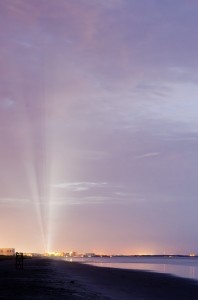 It was your typical cocktail party with everyone standing around awkwardly having awkward conversations, awkwardly introducing people they’d just met to other people they’d just met, while trying to juggle silverware, plate, and drink in one hand to shake hands with the other.
It was your typical cocktail party with everyone standing around awkwardly having awkward conversations, awkwardly introducing people they’d just met to other people they’d just met, while trying to juggle silverware, plate, and drink in one hand to shake hands with the other.
Our hotel was right on the beach, so being a wannabe photographer, I had to go out early in the morning and see if I could get a good photo of the ocean sunrise. When I got out to the beach in the predawn, I was met with a surprise. The spotlights illuminating RBSP’s Atlas V on Space Launch Complex 41 at Kennedy Space Center were clearly visible from our hotel in Cocoa Beach. It was pretty darn cool to be able to see that our spacecraft was there and waiting from so far away. While waiting for sunrise, I also got another surprise photo opportunity. Apparently, August is sea turtle hatching season, and my wife and I got to witness one young, lucky turtle make it from the beach to the sea without becoming breakfast for the lurking sea gulls.
Apparently, August is sea turtle hatching season, and my wife and I got to witness one young, lucky turtle make it from the beach to the sea without becoming breakfast for the lurking sea gulls.
Finally, the day of the launch was at hand! We had tried to go to bed early since our alarms were set for 0030 so that we could get ready and be at KSC to catch the shuttles to the viewing bleachers by 0130. Our plans for an early respite were ruined first by phone calls at 2100, and then by a fire alarm at 2330! Someone had pulled the fire alarm as a prank and woke up the entire hotel sending us all out to the parking lot to escape the ear-splitting alarms in our rooms. So with minimal shut-eye, we headed out to KSC and were at the Banana Creek/Saturn V Viewing Location by about 0200, ready to see RBSP leave the planet. The location was close enough to afford a very cool view of the launch vehicle, but far enough away that we wouldn’t be roasted by the exhaust.
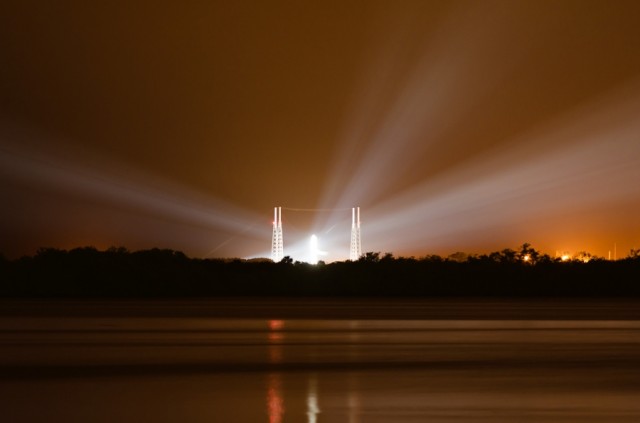
Being right next to a swamp, however, the mosquitoes were vicious! The countdown was approaching the T-4m mark at which there was a scheduled 25-minute hold in preparation for the Readiness Poll for Launch. Once everyone gives the Flight Director a “Go”, then the countdown resumes. We never made it that far. As the various systems were polled for a go/no-go, everyone was good except for down-range tracking. The tracking beacon on the launch vehicle wasn’t holding frequency and the down-range radar couldn’t maintain a definite lock. The launch was scrubbed and scheduled for a second attempt on Saturday morning.
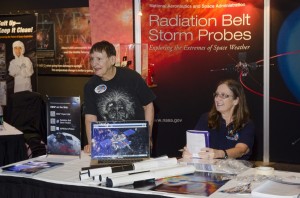 After a couple fitful hours of sleep, it was time to get up again and head back out to Kennedy and the Visitors’ Complex! I volunteered at the RBSP exhibit booth there next to the IMAX theater answering questions about the radiation belts and the RBSP mission, as well as leading youngsters through a variety of short activities we had set up to demonstrate the effects of magnetic and electric fields. It was also a good time to reconnect with some great educators I met at the RBSP Teachers’ Workshop held at APL earlier in the month. My complimentary ticket to the KSC Visitors’ Complex didn’t include access to the bus tour, so no up-close tour of the VAB for me, but they do have a pretty cool Rocket Garden where they have several launch vehicles on static display.
After a couple fitful hours of sleep, it was time to get up again and head back out to Kennedy and the Visitors’ Complex! I volunteered at the RBSP exhibit booth there next to the IMAX theater answering questions about the radiation belts and the RBSP mission, as well as leading youngsters through a variety of short activities we had set up to demonstrate the effects of magnetic and electric fields. It was also a good time to reconnect with some great educators I met at the RBSP Teachers’ Workshop held at APL earlier in the month. My complimentary ticket to the KSC Visitors’ Complex didn’t include access to the bus tour, so no up-close tour of the VAB for me, but they do have a pretty cool Rocket Garden where they have several launch vehicles on static display.
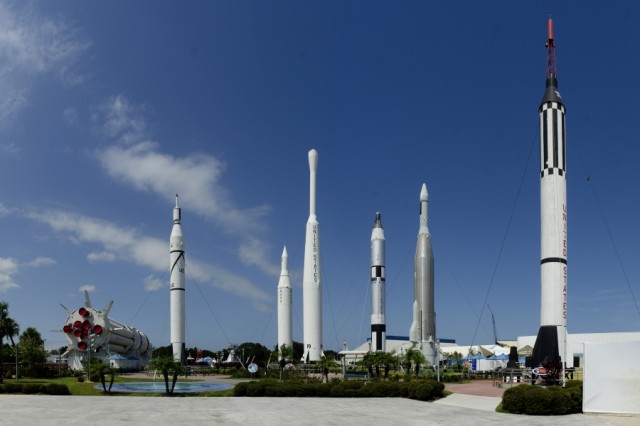
Saturday morning at 0030, it was time to repeat the Friday morning’s routine, thankfully minus the interrupting fire alarm. This time, we made a stop at the doughnut shop for coffee and breakfast. Friday was a struggle without caffeine! The process was pretty much the same as before, show up at KSC and get shuttled to the bleachers and wait. Things were looking sketchy right from the start as we could see lightening off to our south and radar (which everyone had up on their phones) showed a pretty potent cell approaching. It was far enough away that we still had hope that it wouldn’t hinder the launch. At the T-4m hold, though, weather forced a no-go, and it even rained on us for a bit. As the storm cell approached the Cape, the weather conditions became less and less favorable for a launch and once again at 0425, they scrubbed. No launch for us. The night wasn’t a total loss, though. We did get to see an alligator swimming by in Banana Creek right in front of us, and thankfully on the other side of the fence.
As the storm cell approached the Cape, the weather conditions became less and less favorable for a launch and once again at 0425, they scrubbed. No launch for us. The night wasn’t a total loss, though. We did get to see an alligator swimming by in Banana Creek right in front of us, and thankfully on the other side of the fence.
On our way back to the airport, we decided to make one last stop at a museum we learned about through a tip on Foursquare, the U.S. Space Walk of Fame. You’d never know it by looking at the front of the museum as it look more likely to house a barber shop than artifacts from the space program, but they have the best and coolest collection of artifacts and memorabilia I think you’ll find anywhere. Many of the folk involved in the space program as engineers, technicians, scientists, and astronauts have donated a variety of gear and equipment including some of the old launch control panels. The coolest thing about the control panels is that they were powered and kids (or space geeks like me) would enjoy throwing the toggles and watching the different systems come to life.
All in all, it was a good experience. I met a lot of neat people, got to talk a lot of space science and geek out, and I at least got to see our spacecraft on the pad and ready to leave the planet even if it never did launch. Of course there was also all the frolicking in the ocean and enjoying mass quantities of awesome seafood and Cuban cuisine. The next launch window for RBSP is on Thursday, August 30th, at 0305, and you can see the launch streamed live on NASA TV. I’ll certainly be awake and crossing my fingers for a fully green board! GO ATLAS, GO CENTAUR, GO RBSP!
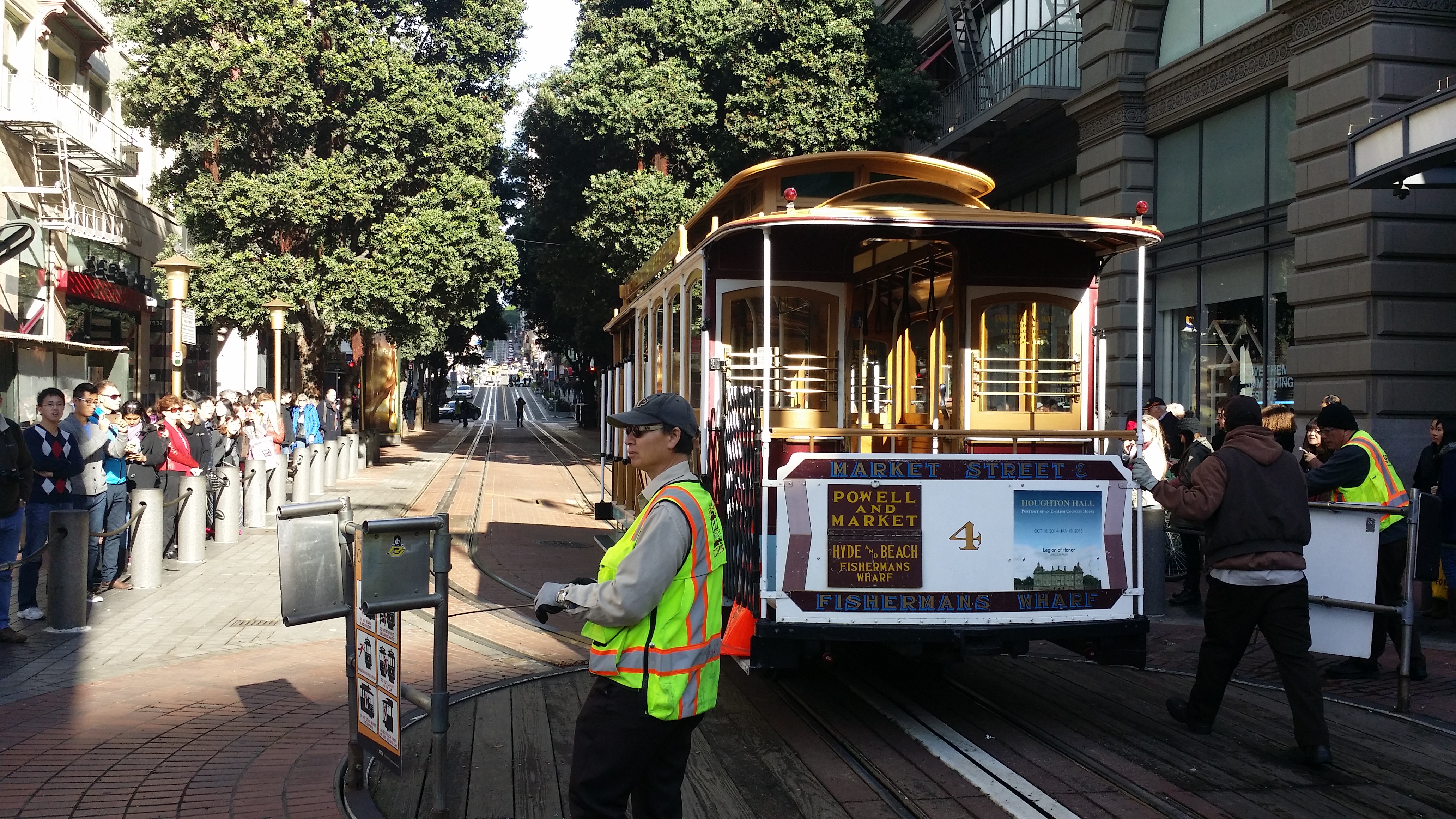

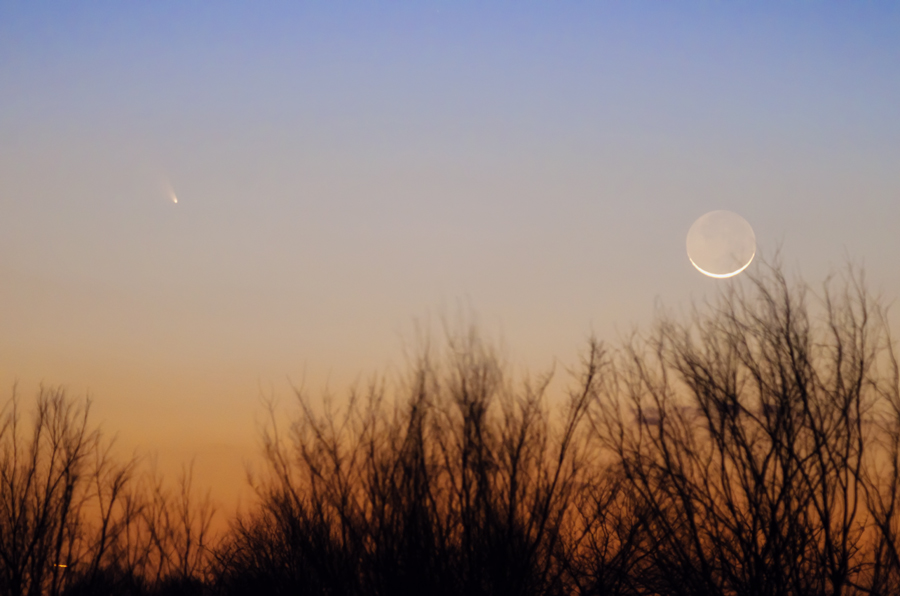
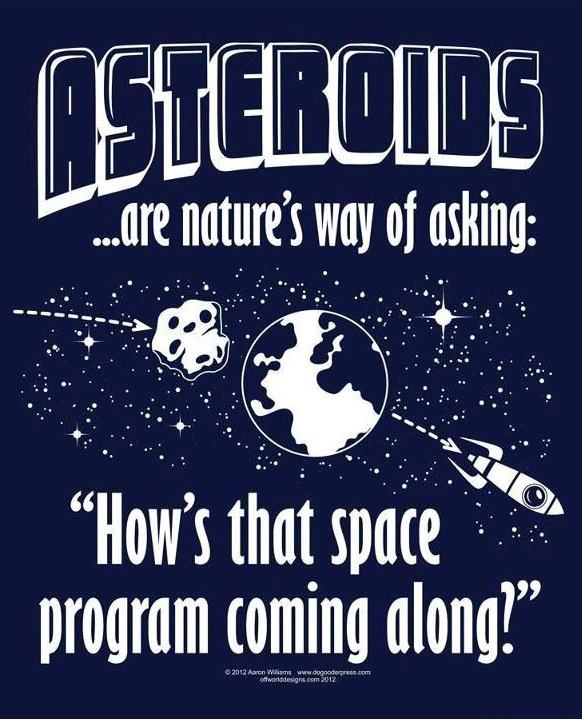
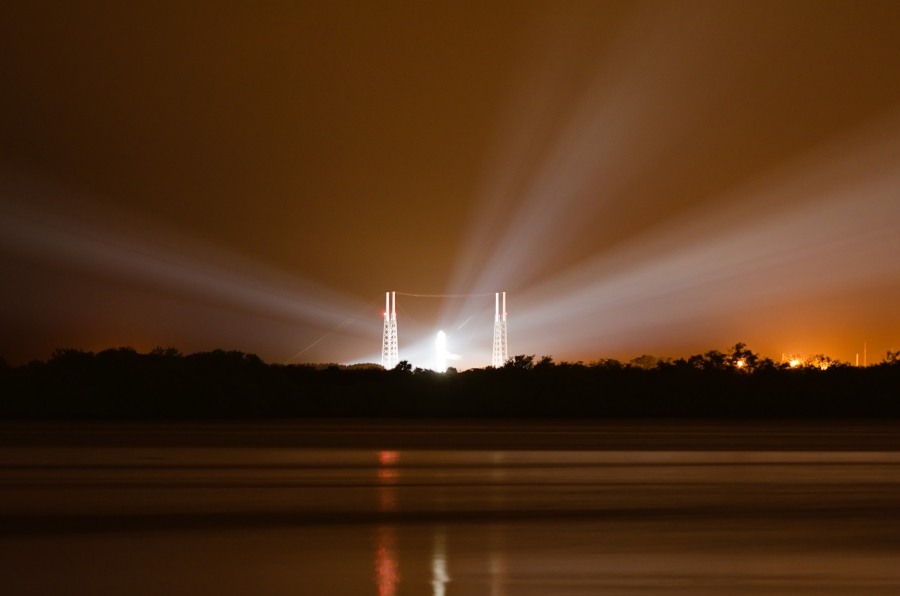
 I recently had the amazing opportunity to go to the Kennedy Space Center as an invited guest to see the launch of a pair of spacecraft, the
I recently had the amazing opportunity to go to the Kennedy Space Center as an invited guest to see the launch of a pair of spacecraft, the  It was your typical cocktail party with everyone standing around awkwardly having awkward conversations, awkwardly introducing people they’d just met to other people they’d just met, while trying to juggle silverware, plate, and drink in one hand to shake hands with the other.
It was your typical cocktail party with everyone standing around awkwardly having awkward conversations, awkwardly introducing people they’d just met to other people they’d just met, while trying to juggle silverware, plate, and drink in one hand to shake hands with the other.  Apparently, August is sea turtle hatching season, and my wife and I got to witness one young, lucky turtle make it from the beach to the sea without becoming breakfast for the lurking sea gulls.
Apparently, August is sea turtle hatching season, and my wife and I got to witness one young, lucky turtle make it from the beach to the sea without becoming breakfast for the lurking sea gulls.
 After a couple fitful hours of sleep, it was time to get up again and head back out to Kennedy and the Visitors’ Complex! I volunteered at the RBSP exhibit booth there next to the IMAX theater answering questions about the radiation belts and the RBSP mission, as well as leading youngsters through a variety of short activities we had set up to demonstrate the effects of magnetic and electric fields. It was also a good time to reconnect with some great educators I met at the RBSP Teachers’ Workshop held at APL earlier in the month. My complimentary ticket to the KSC Visitors’ Complex didn’t include access to the bus tour, so no up-close tour of the VAB for me, but they do have a pretty cool Rocket Garden where they have several launch vehicles on static display.
After a couple fitful hours of sleep, it was time to get up again and head back out to Kennedy and the Visitors’ Complex! I volunteered at the RBSP exhibit booth there next to the IMAX theater answering questions about the radiation belts and the RBSP mission, as well as leading youngsters through a variety of short activities we had set up to demonstrate the effects of magnetic and electric fields. It was also a good time to reconnect with some great educators I met at the RBSP Teachers’ Workshop held at APL earlier in the month. My complimentary ticket to the KSC Visitors’ Complex didn’t include access to the bus tour, so no up-close tour of the VAB for me, but they do have a pretty cool Rocket Garden where they have several launch vehicles on static display.
 As the storm cell approached the Cape, the weather conditions became less and less favorable for a launch and once again at 0425, they scrubbed. No launch for us. The night wasn’t a total loss, though. We did get to see an alligator swimming by in Banana Creek right in front of us, and thankfully on the other side of the fence.
As the storm cell approached the Cape, the weather conditions became less and less favorable for a launch and once again at 0425, they scrubbed. No launch for us. The night wasn’t a total loss, though. We did get to see an alligator swimming by in Banana Creek right in front of us, and thankfully on the other side of the fence.